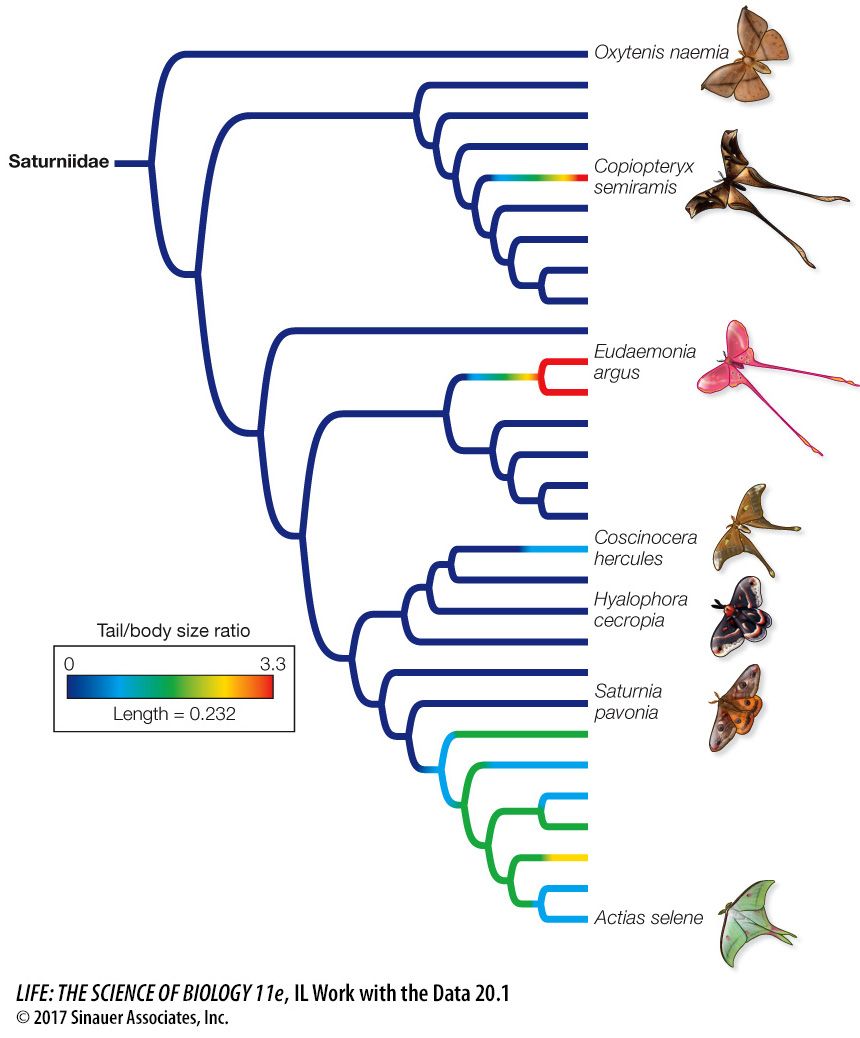Natural selection increases the frequency of beneficial mutations in populations
Darwin knew that far more individuals of most species are born than survive to reproduce. He also knew that, although offspring tend to resemble their parents, the offspring of most organisms are not identical either to their parents or to one another. He suggested that slight differences among individuals affect the chance that a given individual will survive and reproduce, which increases the frequency of the favored trait in the next generation. A favored trait that spreads through a population by natural selection is known as an adaptation; this word is used to describe both the trait itself and the process that produces the trait.
430
investigating life
Do Long Wing Tails Help Moths Escape Bat Predation?
experiment
Original Paper: Barber, J. R., B. C. Leavell, A. L. Keener, J. W. Breinholt, B. A. Chadwell, C. J. W. McClure, G. M. Hill and A. Y. Kawahara. 2015. Moth tails divert bat attack: Evolution of acoustic deflection. Proceedings of the National Academy of Sciences USA 112: 2812–
Many groups of moths have evolved the ability to hear the ultrasounds that bats produce for echolocation. These moths can then use evasive behavior to avoid predation by the bats. But almost half of all moths lack ears to hear the sounds produced by bats. Jesse Barber and his colleagues noticed that many non-

431
work with the data

The experiment shows that the wing tails of luna moths reduce the rate of successful predation by bats. Is this innovation unique to luna moths? Jesse Barber and his colleagues conducted a phylogenetic analysis of moths to understand the evolutionary history of this innovation and how many times it has evolved within moths. Phylogenetic trees were introduced in Chapter 1, and we will discuss them in greater detail in Chapter 21. These diagrams trace the evolutionary history of a group (such as moths) through time, as lineages diverge from a common ancestor. The diagram below shows the phylogeny of moths as reconstructed by the investigators, with a few of the moth species illustrated. The colors of the branches indicate the reconstructed wing tail:body size ratio. Moths along blue branches lack obvious wing tails, whereas moths along green, yellow, or red branches have progressively longer wing tails.
QUESTIONS
Question 1
Based on the phylogenetic tree shown above, how many times do you think wing tail extensions have evolved in moths?
Four groups of moths show clear indications of long wing tails, and each of these groups is closely related to moths that lack wing tails. Therefore the trait must have evolved in parallel at least four times. The long wing tails are present in 11 species on the tree, but some of these species are closely related to one another, and so the trait could have evolved in the common ancestor of each closely related species cluster. Therefore the trait appears to have originated about four times independently.
Question 2
Within a group of moths that have evolved wing tails (such as the close relatives of luna moths), is there any evidence for directional selection for increased wing tail length?
Although the long wing tails appear to have evolved four times independently, there is evidence that directional selection continued in many species as the trait evolved. For example, notice the parallel changes from green to yellow to red (indicating increasing length of wing tails) in many of the species.
Biologists regard an organism as being adapted to a particular environment when they can demonstrate that a slightly different organism reproduces and survives less well in that environment. To understand adaptation, biologists compare the performances of individuals that differ in their traits.
In the story that opens this chapter, we learned that many groups of moths have evolved the ability to detect ultrasounds of bats, which allows the moths to fly away from the bats or use evasive flight behavior to avoid predation. But many species of moths are unable to hear bats, so they would seem to be at a huge disadvantage. As described in Investigating Life: Do Long Wing Tails Help Moths Escape Bat Predation?, Jesse Barber and his colleagues noticed that several groups of non-
Media Clip 20.2 A. luna in Flight
www.life11e.com/
Media Clip 20.3 Big Brown Bats (E. fuscus) versus A. luna
www.life11e.com/
Activity 20.2 Natural Selection Simulation
www.life11e.com/